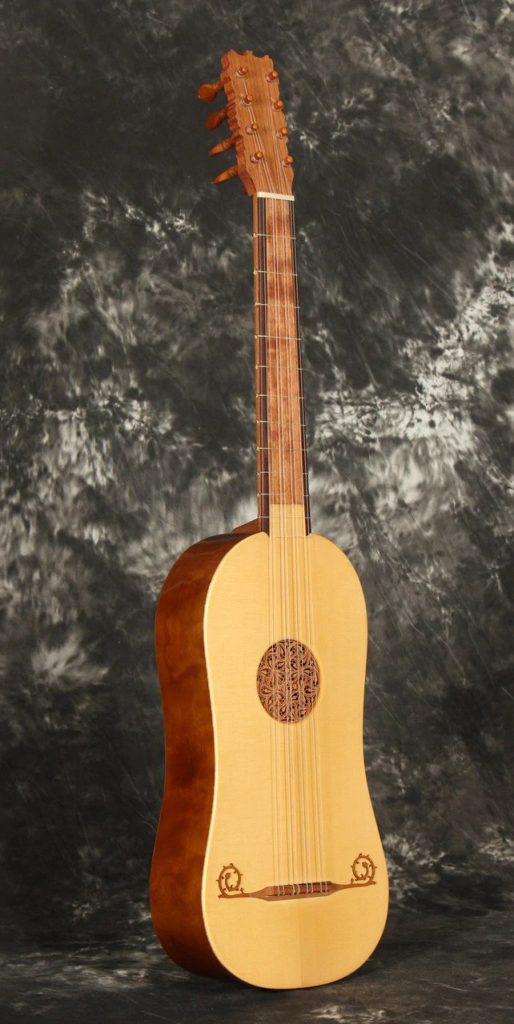Category Archives: All UkulelePlay! Blog Posts
Top 20 Songs for Ukulele Beginners
51 ukulele players from all over the world responded to a recent survey on best songs for beginners to learn on their first day. There were 44 songs presented in the survey. The criteria for this list included broad familiarity and having 2-3 easy chords (though a couple with 4 might have slipped in). The songs were also filtered by 10 years of experience teaching first day ukulele players in my Ukulele Bootcamps. The results of which songs were chosen of these by surveyors is half expected and half surprising. Some songs I thought would be great, were lemons. Some songs I couldn’t have guessed at how popular they were. Here are results:
20 Ain’t That a Shame (Fats Domino)
19 When the Saints Go Marching In (Spiritual)
18 Rock Around the Clock (Bill Haley & His Comets)
17 Splish Splash (Bobby Darin)
16 Simple Gifts (Folk Spiritual)
15 I Still Haven’t Found What I’m Looking For (U2)
14 This Land is Your Land (Woodie Guthrie)
13 Ghost Riders in the Sky (Johnny Cash)
12 Sugar, Sugar (The Archies)
11 Swing Low, Sweet Chariot (Spiritual)
10 Old Time Rock & Roll (Bob Seger)
9 Day-O, i.e. the Banana Boat Song (Harry Belafonte)
8 Surfin’ USA (The Beach Boys)
7 Ode to Joy (Classical Instrumental)
6 Blowin’ in the Wind (Bob Dylan)
5 Leaving on a Jet Plane (John Denver)
4 You Are My Sunshine (Johnny Cash Version)
THE TOP THREE
3 Singin’ in the Rain (Gene Kelly)
2 Twist and Shout (The Beatles)
1 Feelin’ Groovy (Simon & Garfunkel)
I love Feelin’ Groovy, and have since I was in High School when I bought a cassette tape of the best of Simon and Garfunkel. I was surprised though that it came in as peoples number one favorite. Twist and Shout made more sense to me as it is so upbeat. Again, I love Singin’ in the Rain, but another surprise to me to see how popular it is with others.
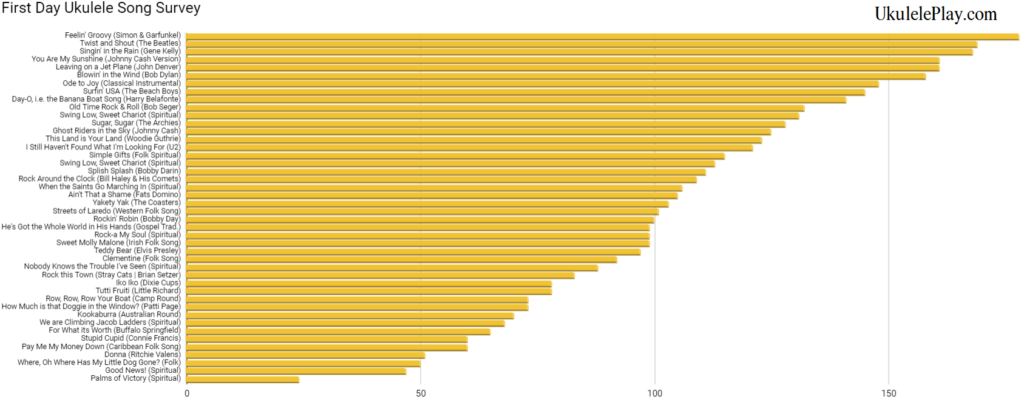
Other Suggestions
I did get a few other great suggestions that weren’t included in the original survey.
- El Condor Pasa (4 chords)
- Riptide (4 chords)
- White Sandy Beach (3 chords)
Though 4 chords on the first day is probably not going to work well in a quick bootcamp, in the following weeks it is entirely possible.
There you go! I hope you find this useful! And here are some more Uke Dogs:

If it were your first day playing ukulele, what songs would you want to learn?
I’m working on my Ukulele Bootcamp 3.0 that I will be teaching in June to new ukulele students. I’ve come up with a big list of possible songs that I think would be great for first time players (2-3 chord songs that are familiar or easy to learn quickly). I’d love to hear what you think! Which of these songs would you most be excited to learn? See bit.ly/ukulelesongsurvey to take the survey.
After submitting, you’ll have the option to see the results of the survey, from those that have taken it so far.
By the by, here are some Uke Dogs …

May Music for Happy Valley Ukes
These are the songs Happy Valley Ukes and supporters on Patreon.com/Uke will be working on in May 2021.
- Good Day Sunshine (The Beatles) – Introduced at the May 8th session
- My Girl (The Temptations) – Introduced at the May 8th session
- Here Comes the Sun (The Beatles) – Introduced at the May 22nd session
- The Tide is High (Blondie) – Introduced at the May 22nd session
Good Day Sunshine and My Girl are the same as the versions found in The Daily Ukulele by Liz & Jim Beloff, so if you already have that, or want to get 365 songs at a great price, look there for those.
Next Happy Valley Ukes Meetups are at the pavilion across the street from the Mt. Timpanogos Temple in Quail Cove Park; the NW corner of 700 N & 900 E in American Fork, UT. ALL members will now meet at 9:30am.
These meetings will be recorded for all members and patrons and posted at Patreon.com/Uke before the following Tuesday.
See this post for more details about live rehearsals.
Cue Cards: What a Wonderful World
My personal cue card, reduced to essentials, from the sheet music of What a Wonderful World. This is one of the songs I’m doing with Happy Valley Ukes in April 2021. You can read about cue cards here. See below the image for additional info on this cue card.
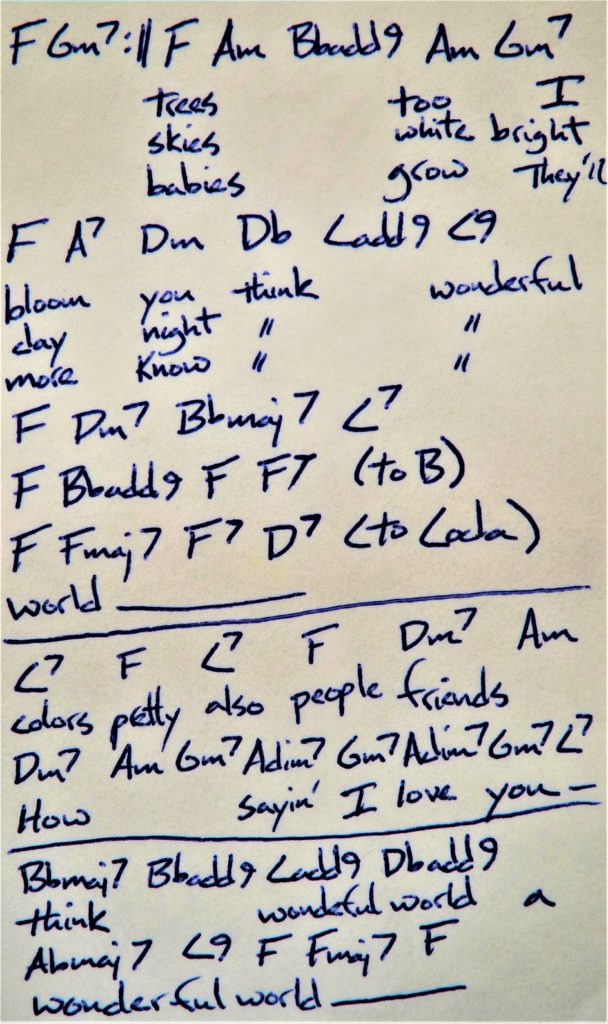
What a Wonderful World follows the classic AABA-Coda structure of many golden-age-of-Broadway musicals (aka 32-Bar Form). Each of the A-sections ends with the refrain “and I think to myself, what a wonderful world.” After the second A, you move on to the B-section (also known as the ‘middle eight’) and then go back to the A-section for the third time. Lastly you skip down to the Coda (not all AABA songs have a coda, but it is nice when they do as it helps wrap up the song). Something else that makes this song extra classy, as well as a little more difficult to memorize is that each of the A-sections has a different set of chords when you get to the last word of the refrain, ‘world.’ This really moves the song nicely and gives the audience some ear-candy.
This is probably the most difficult song I’m doing with the Happy Valley Ukes this season. I already created a sing-along to help. See http://ukuleleplay.com/what-a-wonderful-world-ukulele-sing-along/
You Are My Sunshine Ukulele Sing-along
Nicely legal copies of You Are My Sunshine sheet music may be obtained at http://bit.ly/YouaremySunshineMusic
You can also check out my personal Cue Card for You Are My Sunshine.
Singin’ in the Rain Ukulele Sing-along
Nicely legal copies of Singin’ in the Rain sheet music may be obtained at http://bit.ly/SinginintheRainMusic
You can also check out my personal Cue Card for Singin’ in the Rain.
Enjoy!
Over the Rainbow Ukulele Sing-along
Nicely legal copies of Over the Rainbow sheet music can be obtained at http://bit.ly/overtherainbowmusic
You can also check out my personal Cue Card for Over the Rainbow.
Enjoy!
Cue Cards: Over the Rainbow
My personal cue card, reduced to essentials, from the sheet music of Over the Rainbow. This is one of the songs I’m doing with Happy Valley Ukes in April 2021. You can read about cue cards here. See below the image for additional info on this cue card.
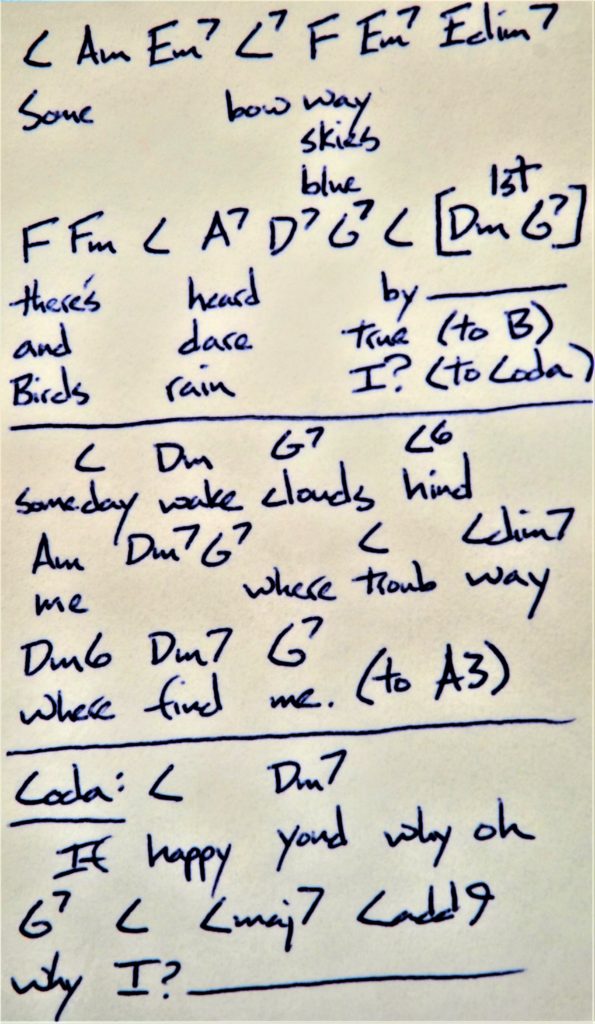
Over the Rainbow follows the classic AABA-Coda structure of many golden-age-of-Broadway musicals (aka 32-Bar Form). Each of the A-sections begins with the refrain “Somewhere over the Rainbow.” After the second A, you move on to the B-section (also known as the ‘middle eight’) and then go back to the A-section for the third time. Lastly you skip down to the Coda (not all AABA songs have a coda, but it is nice when they do as it helps wrap up the song).
See also: Over the Rainbow Ukulele Sing-along
Cue Cards: You are My Sunshine
My personal cue card, reduced to essentials, from the sheet music of You are My Sunshine. This is one of the songs I’m doing with Happy Valley Ukes ‘easy’ group in April 2021. You can read about cue cards here.
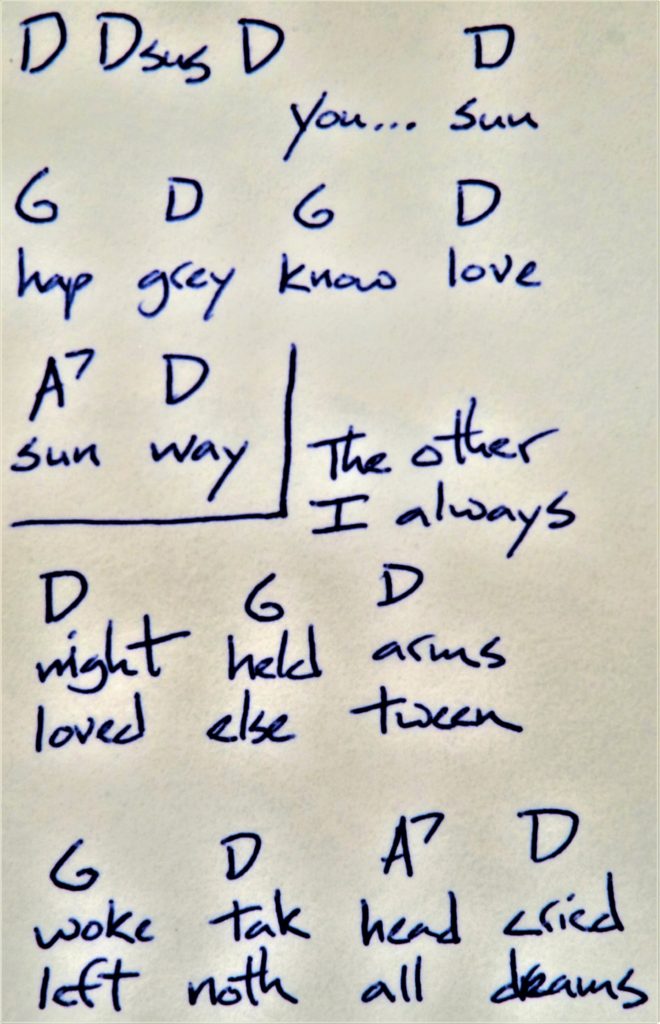
Cue Cards: Singin’ in the Rain
In my most recent article on memorization, I mentioned creating cue cards that contain the most minimal information you need to get through a song or review it … basically a list of chords with lyric ‘cues’ underneath in key places. Here is my 3×5 cue card for Singin’ in the Rain:
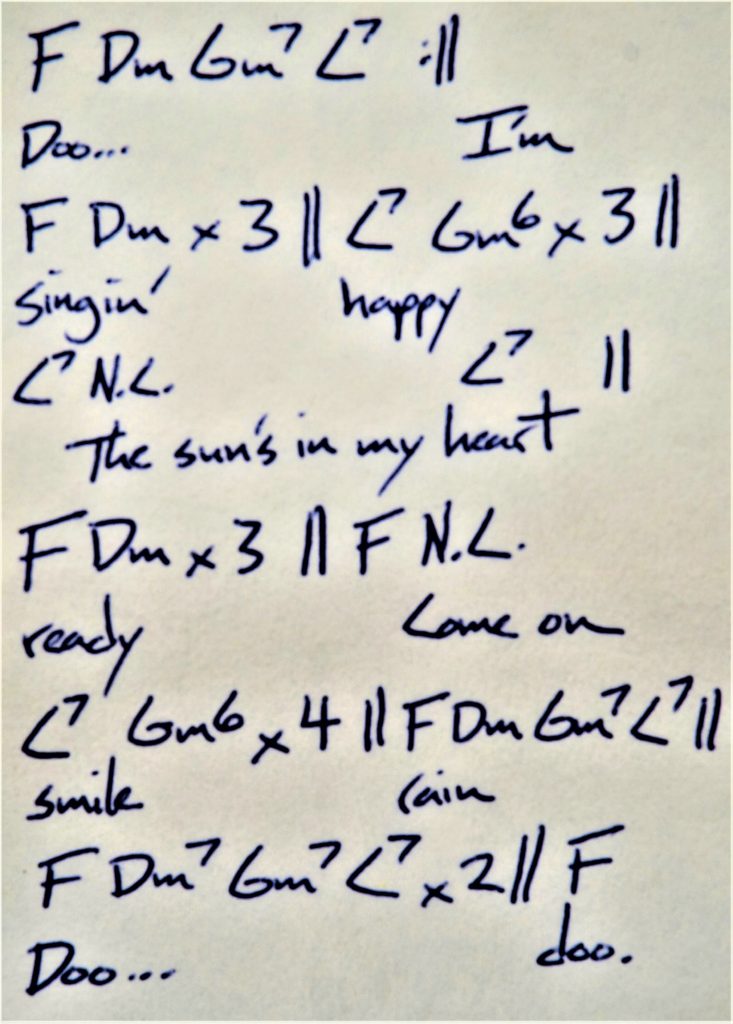
I knew this song fairly well already, so the lyric cues are extremely minimal. No one is going to learn a song from such a minimal set of chords/lyrics, however, copying the song out from the sheet music by hand is a great way to firm up the structure/patterns in your brain. By the time you’ve done that, you should be a lot farther along in your memorization.
And … if you don’t care about being completely memorized, a cue card is a great way to minimize what’s between you and you’re audience:
- Rig some way to clip the card to your mic stand.
- Make a cards on a full size sheets of paper and tape them to the floor to glance at in performance.
- Put the cards on your phone or tablet and use a mic stand clamp designed for your device.
Anyway, I’ll be posting some more of my cue cards as I make them. I have a lot of songs to memorize this Summer for performances coming up in the Fall.
See also: Singin’ in the Rain Ukulele Sing-along
Enjoy!
Memorizing Music : A Short List of Ideas
I’ve written on memorization techniques a couple of times before, but as I try things out I find that certain things work much better for me than others. This is a quick guide to the techniques I currently find most useful.
The Big Picture
- Listen to the song you want to memorize … many times. If you don’t enjoy hearing it many times, then you may want to re-think if you want to take the effort to memorize it.
- Get the sheet music in front of you and analyze it, marking it up as you go. Divide the song up into logical sections (intro, verse, chorus, bridge, aaba, coda, etc.). You’re especially looking for repeating patterns, as these will help you in the memorization process. Don’t worry about being ‘correct’ … your analysis only has to make sense to you.
- Focus your play on small sections. Once you’ve committed a section to memory you’ve got any repeats of that section (i.e. choruses) mastered, or are well on your way toward mastering similar sections (i.e. verses).
- Begin with the end in mind. Many people that have written on this subject suggest starting at the end of a song and working your way backward with the idea that once you start doing run throughs, it is like riding a bike downhill … you coast to the ending, instead of climb into less familiar territory.
- Hammer the parts of the song that only happen once. Anything that doesn’t repeat in a song is going to get less natural repetitions … so make up for it by giving it extra focus in your playing time.
- When you start run-throughs, science suggests that playing through once, going back and fixing any errors, and then letting the piece rest for a while (an hour to a day) before the next run-through … is far more effective than running through a song five, ten or twenty times in a row. You want to train your brain to know that the first time is the most important and that second times rarely come around in performance. Multiple run-throughs in a row signal the brain that it doesn’t really have to commit this info to instant recall … and brains have a lot to do, so they’re constantly looking for info to edit out and forget.
Lyric-Specific Tips
- Read the lyrics without singing them and contemplate/analyze/visualize them as if they were poetry. New meanings and understandings will often emerge that you might not have caught if you only ever sang them. A good example from my experience is Duran Duran’s View to a Kill. Sections of this song don’t make a lot of sense the way the words have been paired to the music, but when read they make complete sense.
- Memorize the lyrics as if they were a dramatic monologue, disconnected from the music … this is a great activity for the shower if you write them them on 3x5s and laminate them. Then sing them. See if there is a difference in your memory as well as the emotional depth that you deliver them with.
- Once again, divide and conquer, memorizing in sections, beginning with the end.
Tips for Chords
- Write out the chord sequences on a separate sheet of paper, or better, on 3×5 cards in sections (chorus, verse, etc.). Make sure you leave plenty of space in-between lines because we’ll be adding lyric cues later.
- Run the chords until you feel comfortable. Focus on any tricky transitions until they are smooth.
- Look for patterns as you practice your chords. Recognizing patterns always helps to reinforce memory.
- If helpful, using a numbering system (like traditional Roman numerals or the more modern and less detailed Nashville numbers) to help you see how the chords relate to each other.
- If numbers aren’t your thing, pay close attention to chord shapes as you make them and the most efficient way to transition from one shape to the next. As someone who is very spatially oriented, I think of shapes matched with fret positions much more readily than I do chord names or numbers. While this limits my ability to transpose on the fly, I see/feel/hear the flow of chord progressions almost like a dance.
- Place a lyric cue words under some chords to help orient yourself. Soon you’ll only need these cards to review your songs. Soon after, you may not even need that. That’s the goal.
Seem Like a Lot?
It is, but for some, memorization does take effort while for others, just seems to happen. You might find, depending on the complexity of the song, that you are long memorized before even getting halfway through this list of suggestions. If not, don’t worry, just keep going.
If you’re still not there by doing everything on this list, don’t worry, just go back and focus on the things that you’re having trouble with (not the easy parts you already know). Keep at it and it will come. I think memorization is achievable by anyone who is willing to put in small, focused, consistent, yet easy effort. Don’t stress, as stress is actually a brain blocker and will make the process more difficult and lengthy.
Why Bother?
Being ‘off book’ has many advantages. While it looks more professional, I wouldn’t use that as my reason. Here are some better ones:
- Feel a much deeper connection to the music. This will bring you joy.
- That joy will show, not only will it boost your mood, but it will also lead to more moving performances.
- Connect with your audience. There is something comforting about having a music stand as a shield between you and the audience; you don’t have to look them in the eye. However, if you really know a song, you can concentrate on sharing that song in love to those that listen. The chances you can send that song to their heart is so much higher.
Review is Important
Once you get a song to the point you feel it is effortless, you’ll want to start some form of ‘spaced repetition‘ program. At first you’ll review songs frequently, but as time goes on, you’ll find you can lengthen your reviews to a week, two weeks, or even a month and still get good results. This will keep that info fresh in your mind while allowing you time to add more songs to your ‘set list.’ Of course, it is always good to review songs you’re going to perform soon.
Break a Leg!
I hope you find this information useful and leads you to experiment with some or all of the above tips. I welcome hearing about your experiences, tips, advice for others, and successes. Just leave a comment below!
The Guitar in Tudor England : Book Review (i.e. why Ukulele players should care)
One word review: Wow!
Want specifics: Read on!
If you’ve been following the blog for a while, you might have seen my earlier post on the Renaissance guitar and the similarities it shares with the modern ukulele. Someone who saw the article mentioned a book by Christopher Page, The Guitar in Tudor England : A Social and Musical History.
The level of research here is mind-blowing, with scores of obscure 16th-century references to the guiterre, gittern, gitterne, etc. (Elizabethans weren’t big on standardized spelling) … the instrument we now know as the 4-course renaissance guitar, which shares many similarities to the modern ukulele. Here are some things I knew going in the book:
- Hourglass shape with flat back and sides made of bent wood (rather than carved from a block)
- Fretted with gut ties like a lute
- Gut strings
- A 4th – 3rd – 4th tuning in 4 courses (sets of strings) … gG CC EE A
Some interesting additions to this that I learned exclusively from Page’s research:
- It came in DIFFERENT SIZES! How cool is that? Today we have our Soprano/Concert/Tenor sizes, all generally tuned the same gCEA as each other, as well as the Baritone in DGBE … Queen Elizabeth was gifted a set of 3 gitterns by a prominent English instrument maker and Page speculates that these would most likely have been of two or three different sizes (one of which may have been the size of today’s soprano ukulele as evidenced by the Eglantine Table of Hardwick Hall).
- In addition to the well-documented gG CC EE A tuning (see The Renaissance Guitar 1500-1650 by James Tyler in Early Music), Page uncovered evidence that some of these Renaissance instruments may have been tuned re-entrant, without the lower octave string, like today’s ukulele.
- He also found an alternate tuning system that maintained the same 4th-3rd-4th pitch relationships, but with different specific pitches. With this information he reconstructs a 3-tiered system of tuning with specific pitches of C4 F4 A4 D5 (a 4th higher than a ukulele standard), F3 Bb3 D4 G4 (a whole-step lower than standard) and C3 F3 A3 D4 (a whole-step lower than baritone). Of course, at the time pitch was much fuzzier when it comes to specifics, but this is still cool. A modern parallel would be Sopranino, Standard and Baritone ukulele tunings.
- Lots of strong evidence that the instrument was primarily used in England to strum chords while accompanying the voice, though translations of French method books were published that showed that there was enough interest in playing it instrumentally to merit the effort.
There was sooooooo much more to this than instrument specifics though. Page explores how the instrument was popular in different layers of the social strata. The instrument belonged to:
- Henry VIII (possibly)
- Queen Elizabeth (definitely)
- Courtiers
- Spying Courtiers that used the instrument to carry a cipher
- Nobles
- Merchants
- College Men
- Taverners
- Young Wastrels
It was fascinating to read about these people, the import trade on gitterns (instruments mostly came from France), evidences in the visual record, music that was played, and many interesting appendices. Well worth the time. A great book. Five stars. *****
What a Wonderful World : Ukulele Sing-along
I created this ukulele sing-along for What a Wonderful World as a reference for my Happy Valley Ukes players … I LOVE this song, and though I don’t sing it with the gravel of Satchmo, I hope you enjoy my version anyway.
I’ve put in chord diagrams for LOTS of ‘up the neck’ inversions of chords … if you know your root position chords, go ahead and substitute; I arranged with the thought of more than one player singing and strumming together, with some on the roots and some on the inversions.
Also, I’m playing this in a very staccato jazz-like manner … if you are playing in a group it would be nice to add some people on fingerpicked arpeggios to get that 1 2 3 4 5 6 1 2 3 4 5 6 groove going that really makes this song a 12/8 rather than a 4/4 song. Using string numbers in a pattern, you would do 3 2 4 1 4 2 3 2 4 1 4 2 to get an ascending/descending arpeggio (I usually just alternate my thumb and first finger on this pattern).
Nicely legal copies of the sheet music can be purchased at http://bit.ly/wonderfulworldukulele
Why do I lead the Happy Valley Ukes?
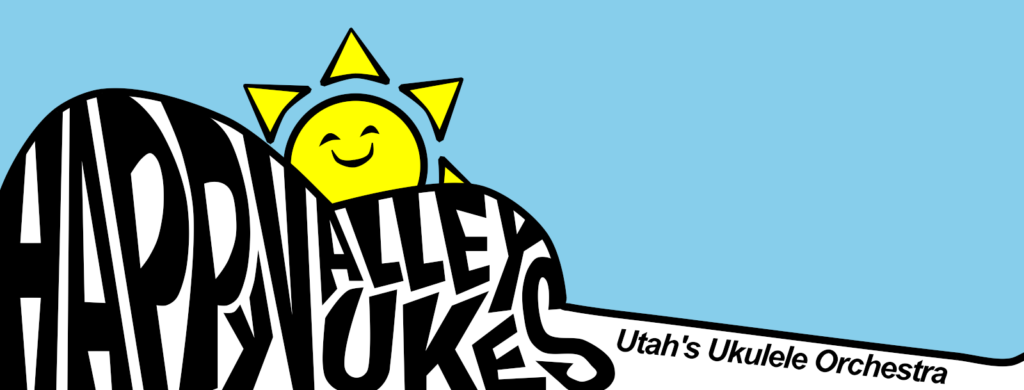
I know the past year has been hard for most everyone. While I’m actually grateful for the extra time I’ve had with my little family, whom I love to hang out with, I am at times prone to rumination and depression. Isolation really drove that side of me home. There were a lot of things this year that intensified that darker side of my personality, but I felt the greatest loss in not being able to get together and make music with people …
When I entered high school I intended to become a visual artist. Somehow, long story, I ended up taking choir and marching band instead of art. Just like that I got hooked on music, but not just any music … group music. I grew up in a musical household (my dad was a band director), but I’d never really experienced the high and the comradery that is born out of making music live with other human beings … it enhances and deepens the power of music in so many ways. When I got interested in ukulele a decade ago, I recognized it as a way to get others together making music and experiencing that joy. People who might not have had a chance to do so in the past. That is the reason for Happy Valley Ukes.
Come Join Us
- Details: https://www.patreon.com/posts/49353700
- Music for April: https://www.patreon.com/posts/49803589
Utah Live Ukulele Classes Resume April 10th
Interested in learning Ukulele in a fun group environment? or already play and want to join in with others? Happy Valley Ukes will be begin outdoor rehearsals on April 10th … Beginners at 9:30am and continuing students at 10:30am. Classes will be at the pavilion across the street from the Mt. Timpanogos Temple in Quail Cove Park (NW corner of 700 N & 900 E in American Fork) … see https://www.patreon.com/posts/49353700 for full details.
A Flea and a Fly – Uke & Me Kid (Ukulele Songs for Children)
Sheet Music
- A Flea and a Fly on Sheet Music Plus
- Also available freely to patrons at Patreon.com/Uke
Improvise for Real on Ukulele
Although this isn’t specifically a ukulele topic, I’ve had several students that were interested in improvising. I can say this is definitely not my specialty, but I came across an interesting video today that really sparked my curiosity …
My first thought was, “That was cool!” What a beautiful, simple and easy way to illustrate and start experimenting with improvising. I searched out the Improvise for Real channel and found this video that explains what is going on here with ‘Melody Paths’ …
If you find the numbers system new, a quick explanation is that in the key of C, C=1 and B=7. In the key of D, D=1 and C#=7, and so on. What I adore about the above though is taking and drawing it out so you can see the ‘melodic paths’ more easily. Fantastic.
The channel has a ton of additional free video content, including backing tracks to practice with, so check it out if you’re interested in expanding your improvisatory playing.
Lift Up Your Voice & Sing – Sing-along & Tutorial
Free Sheet Music
About
One of my favorite ‘primary’ songs for kids. My mom was the chorister who taught this to me as a child in ‘primary’ at church, so it has a special place in my heart. Most of the song is F & C7 with a few other chords in, so it is great for beginners. If you have some students, your own kids or grandkids, or want to perform for young folk, this is a great one to add to your repertoire.
Gear in this Video
Support this work at http://patreon.com/uke
Spicing up Major Chords with the Easiest Sus4 Routine for Ukulele

One of the easiest ways to ornament (i.e. spice up) your plain vanilla major chords (especially when they’re hanging out for more than a couple of beats) is to add suspended fourths.
What is a suspended fourth?
When you take the middle note of the chord (the third) and raise it half a step it becomes a ‘suspended’ fourth.
Why is it called suspended?
Because the fourth has a tendency in our ears to want to resolve back down to the third, therefore it is ‘suspended’ over the third and adds suspense an anticipation of the resolution (anticipations are however a different kind of ornament).
How can I learn which note to raise to create a suspended fourth in a major chord?
The middle note, or third, of a major chord changes position on the strings depending on which chord you’re playing on the ukulele. On C it is on string 2, but on G it is on string 1. To make things easy for me, and anyone else interested, I’ve created a chart of the ‘easiest’ sus4 fingerings for each of the 12 major chords. You can download it right here:
What are some ideas for using this?
You will notice that I did NOT use all the ‘root position’ chords in this chart. For some chords, making the transition between major and sus4 is much easier further up the neck. You’ll also notice that some of the barre chords repeat the same patterns (Bb & B as well as Db, D, Eb, E, F# & Ab); this means that there are less patterns to memorize than you might think.
- Play through all the chords.
- Play the idiomatic Major to sus4 back to Major that you find in a lot of songs.
- Pull out some songs you know and throw in some sus4 chords on major chords that hang around for 3 or more beats. Sometimes it will work fantastic and others it won’t. Experiment.
- Use a pencil to mark the instances of sus4 that really add to the emotion of the piece. It can be overdone and lose its effect, so be careful.
Happy sussing!
Great Performances: Top of the World – Carpenters Cover by Rio
This really took me on a trip back to my youth. I remember playing this album over and over … on 8-track tape!
How ancient is the ukulele?
Stumbling Upon the Ukulele’s Oldest Living Relative
It is well-documented that the Hawaiian ukulele traces its heritage across the ocean to the 19th-century island of Madeira (see The Birth of the Ukulele, Ukulele Magazine, Fall 2014, The Mighty Uke, or The ‘Ukulele: A History). Would you be surprised, however, to find out that the earliest known relative of the ukulele was actually a four-course, seven-stringed instrument tuned exactly like a modern ukulele (gG CC EE A)? This mystery instrument was being played across Europe at the same time Shakespeare was penning “A Midsummer Night’s Dream,” and was popular on the continent in France, Spain & Portugal as well as in England … Queen Elizabeth was gifted three of them on one occasion (opens YouTube). Where had this instrument been hiding? How did I find out about it? Read on …
My Renaissance Rabbit-hole
Singing concerts full of renaissance madrigals accompanied by period instruments was one of the highlights of my college days (thank you Bruce Bales). Later I took courses in 16th-century counterpoint and Renaissance music history as part of my masters degree in music composition. I still love listening to or singing Dowland’s ‘lute songs’ when I get a chance, so when I came across a ‘lute-kulele‘ I felt had to have one. This is just the first step of the journey though …
The lute-kulele is a lute-shaped, tenor-scale ukulele with six strings in four courses; they are tuned in re-entrant gCCEEA by the manufacturer, but I think sound more ‘period’ with the linear tuning GCCEEA. I discovered this when researching the instrument and coming across the masterfully-played youtube videos of Stefan Dollak, who calls the instrument a ‘4-course lute.’ I messaged Stefan to ask about sheet music, but professional that he is, he answered that he was making it up and/or adapting it on the fly.
In searching to see if there was any 4-course lute music out there I didn’t come across much, other than a peculiar lute tuning of GDAG from The Lute Society’s lute tunings page, which confirms the existence of a 4-course lute in medieval times. Upon further search I found a page from The Lute Society of America (LSA) entitled, “Relatives of the Lute : Renaissance Guitar” (which unfortunately disappeared when they moved their website) … what I found there really surprised me.
The Renaissance Guitar … The Renaissance Ukulele?
It turns out that ukuleles, as we call them today, were being played five hundred years ago, at least if you consider a small guitar with a “My Dog Has Fleas” tuning of GCEA to be worthy of the name. Today we call this historical instrument the Renaissance Guitar, although it had many names in the 16-17th centuries (depending on the nation). It is believed to be the ‘original’ guitar, as no records of older instruments exist that use this body-shape/tuning-relationship (fourth, third, fourth still present in the top four strings of modern guitars, transposed down). Although the scale-length of the Renaissance Guitar was longer than a baritone ukulele (50-55cm or 19.7-21.7in), it had the signature guitar-shaped body and was tuned like a modern ukulele.
Is it an ukulele though? It depends on your definition. I’ve heard it argued that the only ‘true’ ukulele is a soprano-sized instrument with peg-head tuners made of native Hawaiian Koa wood. But I choose to be more flexible with my definition. As the saying goes, ‘If it walks like a duck, and talks like a duck …”.
I think it is safe to say though that with the advent of the Hawaiian ukulele in the late 19th century, the guitar has in ways come full circle. I suspect that if we could trace the lineage back through the folk instruments of Madeira that were brought to Hawaii, we might find that the ‘original’ guitar never actually went away, it just traveled a lot, and for good reason.
How Was it Played?
As for the Renaissance Guitar’s use, the now missing LSA article stated, “During the Renaissance, the guitar may well have been used as it frequently is today, to provide a simple strummed accompaniment for a singer or a small musical group. However, there were also several significant music collections published during the sixteenth century containing contrapuntal compositions for guitar approaching the complexity, sophistication and breadth of repertory of those appearing in some publications for lute from the same time period.” Reading this was a ‘wow!’ moment for me.
Where Can I Get One?
Fortunately, I found a Renaissance Guitar replica in stock from from the German music company Thomann and ordered it so I could see what playing a super-long scale 7-string tenor ukulele was like. When it eventually came, I did have to get used to the gut frets that are tied to the neck (same as they are on the lute – apparently wire frets were a later invention), but the playability has proved amazing and the voice of the instrument is uniquely rich. Some other places that offer replicas include:
All of the above ‘authentic’ options are over a thousand USD. See below for more ‘poor man’ options.
Breaking it In
When I purchased the Thomann Renaissance Guitar in 2018, I felt it was appropriate to break it in with some new settings of song texts from the plays of William Shakespeare (1564-1616). I performed these at the 10th anniversary concert of the Salty Cricket Composers Collective. I also set a poem by Robert Herrick (1591–1674) for Christmas (on Facebook). I post this second one just to give you an idea of what the instrument sounds like and how I’m using it, coming from a decade+ of ukulele playing. I’m planning to record the Shakespeare settings this year.
How did it sound ‘Back in the Day’
If you’d like to hear examples of how the instrument was played ‘back in the day,’ I’ve located some wonderful recordings by some amazing players who have released recordings on Amazon. See “Comiença la musica para guitarra” by Massimo Lonardi, “Tabulatures de guiterne” by Michael Craddock, and “Renaissance Redux” by Jacopo Gianninoto. All of these are worth checking out.
Sheet Music for Renaissance Guitar
Although you can find lute-style renaissance guitar tablature (handwritten, with letters instead of numbers) for free on a number of web archives, Michael Walker has published modern transcriptions of almost all the music available for the renaissance guitar, and adapted other period music for the instrument. Although he has labeled these editions for baritone ukulele or modern guitar players (using only the top 4 strings), the tablature can be played on modern GCEA ukuleles and will sound in the original keys (just note that the staff notation will be a fourth off from what you’re playing). UPDATE: Renaissance Ukulele on blogspot has posted MANY free transcriptions of music from this period.
I would recommend playing with a low G for these transcriptions, or if you can spring for another ukulele, you might try any of the following ‘poor man’ Renaissance Guitar configurations:
- Kala KA-ATP-CTG Solid Cedar Acacia 5-String Tenor Ukulele with low and high g-strings on the fourth course : This will give you that wonderful double octave on the G, but single strings for ease of play on the remaining courses. The scale length is much shorter, but you’ll be playing all the same notes.
- Oscar Schmidt OU28T Ukulele : This well-reviewed 8-string with double courses on all the strings is closest you can get to the sound of the renaissance guitar for under two hundred dollars. Again, the scale length is nowhere near the size of a replica.
- Kala KA-ABP8-CTG Solid Cedar Acacia Baritone 8-String Ukulele (not available on Amazon the day of posting 2/4/21 likely due to pandemic issues, but search around and you may find one) : I purchased this baritone ukulele to see if I could make a ‘poor man’s’ renaissance guitar out of it. The scale-length is close enough to my replica and you get the distinctive sound of the double courses. I switched out the stock strings for a custom set of La Bella rectified nylon lute strings (recommended for renaissance guitar by Stefan Dollak) that I tuned up to GCEA. This works well, but is a bit more tense than the replica’s strings, which the manufacturer said were Aquila strings. I also ordered a custom set of new nylgut strings direct from Aquila in Italy, but it was a hassle and I think I like the La Bella’s fuller sound better (demo video to come).
Wrapping it Up
This renaissance rabbit-hole I quite accidentally stumbled into has made me reexamine my thoughts about the ukulele and what makes a uke a uke. While the instrument undoubtedly made its way through Madeira to Hawaii to the world, for which I am very grateful, the DNA makeup of the instrument is far more ancient. It seems to me a bit like when you dig into your personal ancestry and find out that you’re distantly related to Lady Godiva (which I am). In the end, how far the lineage traces back matters less than what we do with the instrument today. Whether you play ‘for fun,’ ‘for joy,’ ‘for others’ or ‘for community’ or all of the above says more about the you than the instrument you use. I’m grateful for all those that teach and have taught and brought so many people together through the ukulele, whether the origin of the instrument be new or old.
More to Read
- The Renaissance Guitar 1500-1650 by James Tyler in Early Music
- The Guitar in Tudor England by Christopher Page
- The Guitar and Its Music from the Renaissance to the Classical Era by James Tyler & Paul Sparks
- Christopher Page lecture: The Guitar in Tudor London.
- Renaissance Ukulele on blogspot has posted MANY free transcriptions of music from this period.
Addendum
This post has been edited as new information has been made available to me.
Several forum readers wondered why I didn’t focus on the Madeiran connection. One wrote to me to say:
This article is jumping on the bandwagon of genuine academics such as Christopher Page who have properly researched the Renaissance guitar … The connection between the Renaissance guitar and the ukulele is very interesting and compelling but all evidence (see King and Tranquada) supports the idea that the ukulele came to Hawaii from Madeira. The size comes from the machete and the tuning from the rajão. So where is the link between the Renaissance guitar and Madeira?
My reply:
While I am not employed in musical academia, I do have a masters degree in music and have researched and written many a paper, having spent plenty of time at the university library … one emphasis of study was Renaissance music for my masters degree. There is nothing unethical about reporting on the research of others if that research is credited, which I have done in many ways. While I was unaware of Christopher Page’s work (thank you for making me aware), I have referenced the mentor of one of my personal teachers under which I sang several full concerts of renaissance music, James Tyler, who’s article in Early Music is linked to, as well as John King who’s books got me started playing classical music on the ukulele in the first place.
I am fully aware that the ukulele came to Hawaii via Madeira and reference that in the very first paragraph of the article, “It is well-documented that the Hawaiian ukulele traces its heritage across the ocean to the 19th-century island of Madeira (see The Birth of the Ukulele, Ukulele Magazine, Fall 2014, The Mighty Uke, or The ‘Ukulele: A History).” This is a message to state, “Go read about that part of the story there.” My article is about my own personal discovery of the Renaissance guitar and how interesting I find it that this is the first known guitar-like instrument to sport the GCEA tuning. Are they ‘directly’ related. Not at all. I feel it is more like the great grand-daddy of the ukulele.
My speculation, and it can only remain a speculation (and academia is full of them), is that instruments like the rajão held on to this tuning in folk circles and then passed it on to the ukulele. Until we learn how to time travel though we’ll never know for sure …
Fun Finds: One of a Kind Ukuleles for the Wallace & Gromit Fan
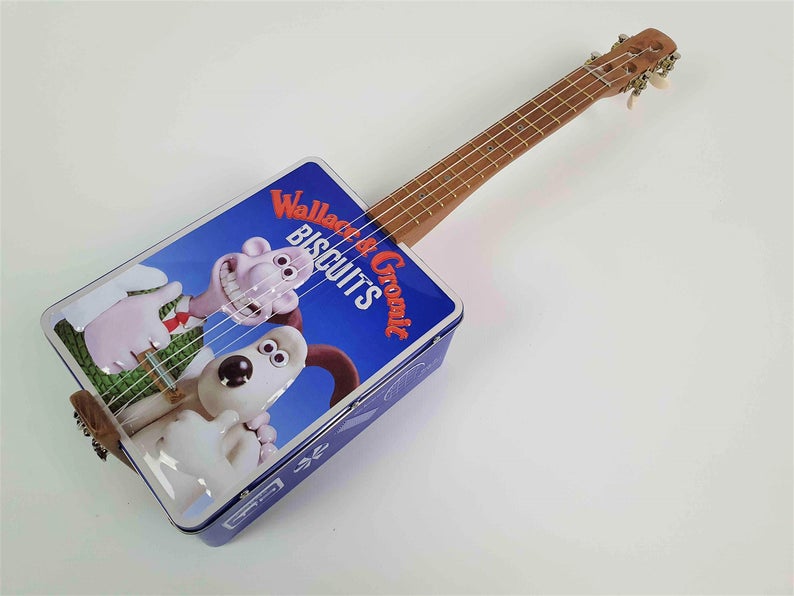
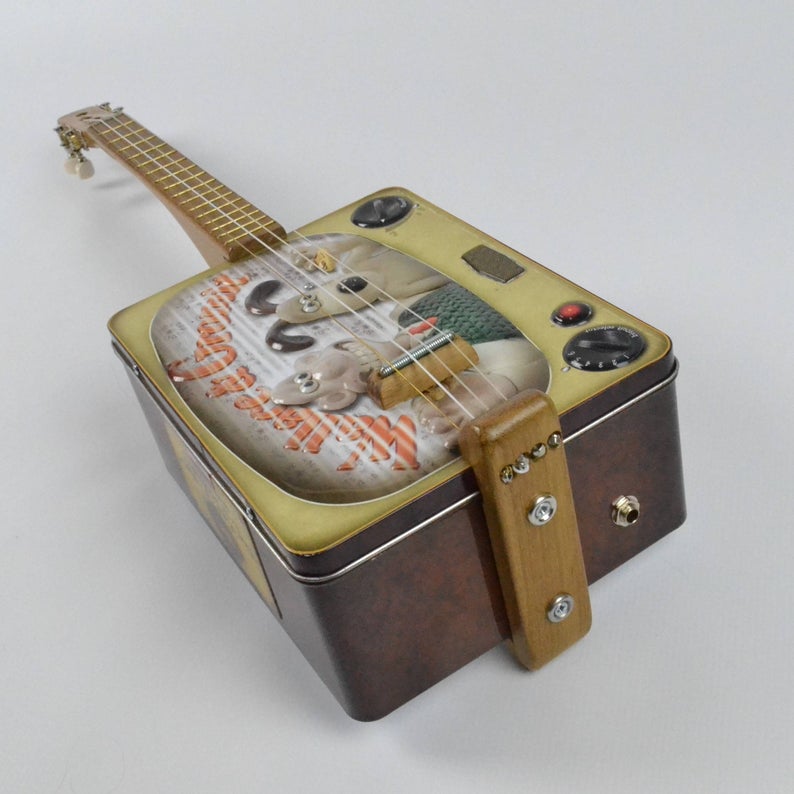
Say cheese! 🙂
Ukulele Sidekicks: Ocarina
What goes good with ukulele? Almost everything really, but in this Ukulele Sidekicks series I’ll be exploring some logical ukulele companions that you can get going on easily if you have multi-instrumentalist aspirations and want to bring a different sound to your ukulele group, whether it be an informal jam session, a regularly rehearsing ukulele orchestra or just a small duo.
My experience with ocarinas.
I was first exposed to the ocarina as a child. My oldest brother was a missionary in Chile for two years and brought home two beautiful clay ocarinas in different sizes. I thought it was sooooo cool and really wanted to learn how to play it. Unfortunately, no one in my family knew the fingering system and the internet was still a long ways away from providing easy reference for info on almost any subject.
Fast forward forty years. I decided it was time to fulfill my childhood longing and I bought a Focalink Osawa Soprano C Ocarina. It is an awesome instrument and was under 20 bucks. Having played other wind instruments since I was a youth (my father was a band director), it didn’t take me long to pick up the basics with a fingering chart in hand. I featured this instrument in my cover of The Lion Sleeps Tonight, as a replacement for the background operatic soprano in the original recording. I think it worked nicely there. I also purchased a soprano G and an alto C, but haven’t made as much use of those, mostly because I love the bright and cheery range of the soprano in C.
Stepping Up to Purple Clay
I’m planning a performance at the Renaissance Faire next Summer and am planning to include the ocarina in my instrument line-up (as vessel-flutes have been around since ancient times, even though the modern ocarina is only a couple hundred years old). The bright plastic yellow of my first soprano ocarina feels like it would be a little out of place among all the leather and homespun cloth. So …
After doing some research, I ordered a new purple clay soprano ocarina in C marketed as one of the pro-level instruments by STL Ocarinas. It happened to be on sale for eighty dollars (you gotta love that a pro-level ocarina costs about the same as a beginner-level ukulele). It finally came after some shipping delays (darn pandemic) and …
I am in LOVE with this thing (recording coming soon!). It offers a pure, piercing sound that is going to carry well in an outdoor setting. It also is easier to play and stay in tune with itself (though my yellow ocarina was no slouch).
Ocarina Acquisition Syndrome?
Like ukuleles, ocarinas are relatively inexpensive instruments, and it is easy to start collecting. There is also a practical reason to own several ocarinas, as they come in a variety of keys and ranges.
What key should I get?
Common keys for the ocarina are C, G & F. While 12 hole ocarinas are chromatic, meaning they can play in any key, they are easiest to play in their ‘home’ key as well as a key one fifth up and another one fifth down (the closest keys on the circle of fifths). Therefore, an ocarina in the key of C will most easily cover the keys of C, F and G, while the G ocarina models are most practical in G, D & C. Finally, the F ocarina models are easiest in F, C & Bb. So if you have 3 ocarinas in C, G & F then you can easily cover songs in Bb, F, C, G & D. With a little practice you can add Eb & A to that lineup of keys. Other keyed instruments may be available if you search around, but these cover the most common ukulele keys anyway.
What range should I get?
Ocarinas come in Soprano, Alto, Tenor and Bass ranges. While a lot depends on the model, ocarinas are generally louder in the soprano models and very quiet in the bass models (the higher the louder, the lower the softer). Caveat: the material the ocarina is made out of and the quality of construction also effect volume (read reviews before buying). For live performance, without amplification, soprano and alto models are probably the best. If you’re willing to mic or are planning to record in a studio, any model can be made to work as long as it is a quality instrument.
How do I play the ocarina?
I like method books, so I purchased the Hal Leonard Ocarina Method which is just under fifteen dollars. It really is an excellent book and I plan to record some of the melodies it covers in the future.
Getting started though is as easy as referring to an ocarina fingering chart and blowing (less air for lower notes, more air for higher ones). One of the cool things about ocarinas is that they are a transposing instrument, so you only need to learn one set of fingerings to play any 12-hole instrument, and you will read music in C. However, this can be a problem when playing with others if you don’t know how to transpose music. Because of this I would definitely suggest getting a C instrument if you’re not familiar with a lot of theory and transposing seems daunting. Later on you can branch out when you feel comfortable with the concept that a G instrument will play a G when you finger a C, and an F instrument will play an F when you finger a C. On a C instrument, a C is a C is a C, of course.
What should I play on ocarina with ukulele?
Here are some ideas for incorporating your new ocarina skills in your ukulele group:
- Instrumental riffs integral to a song can be covered on ocarina. Imagine the opening guitar riff on Layla, or the flute part on Down Under … these would be awesome on ocarina.
- Just play the melody for a verse.
- If you have arranging or improv skills, play a new countermelody of your own.
- Many older songs like Blue Skies, or Over the Rainbow follow an AABA song form. This makes for very short songs by today’s standards. Often times in the original recordings of these songs they would extend the song by doing a second instrumental B-section and then doing one last chorus of the A-section, making the song AABABA in form. This second B-section is an ideal place to cover the melody, simply or jazzed up, on ocarina.
Of course any of these ideas and more will work if your a multi-tracker in your own studio as well.
Transposing from Standard to Baritone Ukulele
If you’d like to try your hand at baritone ukulele, but find the idea of learning a whole new set of chords daunting, try thinking of transposing from standard (GCEA) to baritone (DGBE) this way:
- There are only 7 note names: A B C D E F G … A B C etc.
- All of these can be sharped # or flatted b, but E#, B#, Cb & Fb almost never seen as they are the same as F, C, B & E respectively.
- The C chord shape is the G chord shape on a baritone.
- This means any chord on standard will be three steps down … C (skip B & A) becomes G.
Thus:
D shape becomes A.
E shape becomes B.
F shape becomes C … etc.
If you add a sharp or flat …
Db becomes Ab.
F# becomes C#.
Hope that helps!
On Christ, the Solid Rock, I Stand (aka My Hope is Built on Nothing Less)
On Christ, the Solid Rock, I Stand : Also known as My Hope is Built on Nothing Less. Lead sheet and chord indications. If you need to look any of these chords up, my favorite tool is UkeBuddy.
If you’re unfamiliar with the tune, here is a separate version of this song I produced (different keys than the version above):

